There is ribbon cable which is connected with a locking mechanism as in the picture below. The brown plastic locker is not locking properly, is there a way to get another locker and lock it in place with something else, for example glue?

There is ribbon cable which is connected with a locking mechanism as in the picture below. The brown plastic locker is not locking properly, is there a way to get another locker and lock it in place with something else, for example glue?

That's a "flat flex" cable (not a ribbon cable), and the connectors are not really intended to be repairable.
The proper fix would be to replace the connector with a new one, but this requires a person with fairly good SMT skills and equipment.
If you do try glue (e.g., "Superglue", or cyanoacrylate), be extremely careful to keep it away from the actual electrical contacts. I would recommend staying away from the runniest formulations; use one that has a bit of thickener it it.
This video gives a really neat, cheap and easy fix that might work before you start gluing or replacing the connector:
Easy Ribbon Cable Connector Fix, Repair:
If your connector's locking clamp is merely loose, rather than straight-up broken, you may be able to tighten the connection by cutting a piece of electrical tape to the size of the cable head and applying it to the back (non-contact) side of the cable. This makes the cable slightly thicker and increases the clamp pressure. It worked for me fixing a loose touchpad FFC.
I thick you could use some kind of RTV glues I recommended this part number "Kafuter RTV 704"
very good for fastening connectors and big parts like large capacitor. It's a bit soft but you can not tear it; it is possible to remove it but hardly.
As @DaveTweed mentioned, your picture is not of ribbon cable, but of FFC (Flat Flexible Cable; while not completely equivalent, the term is sometimes used interchangeably with Flexible Printed Circuit, or FPC). If you're brave enough to try to replace the connector, you'll want to use FFC as your search term on your favorite distributor's website.
There are a couple of other options for fixing the connection--one is lower risk, the other is more durable. The lower risk option is to attach a piece of tape with a very strong adhesive to the cable, leaving enough of the end of the cable free that it can properly insert into the connector. Then attach the other end of the tape to the connector itself.
The more durable option is to partially pot that section of the circuit board with RTV or epoxy. This is more risky because of the danger of getting your potting material between the cable and the connector contacts, but it will provide great durability. To keep the contacts clean, you could try to insert something between the non-conductive side of the FFC and the connector to ensure a tight fit. A thin piece of plastic would work well--just make sure it's non-conductive.